
The Game Boy Advance (GBA) is a 32-bit handheld game console developed, manufactured and marketed by Nintendo as the successor to the Game Boy Color. It was released in Japan on March 21, 2001, in North America on June 11, 2001, in the PAL region on June 22, 2001, and in mainland China as iQue Game Boy Advance on June 8, 2004.

A handheld game console, or simply handheld console, is a small, portable self-contained video game console with a built-in screen, game controls and speakers. Handheld game consoles are smaller than home video game consoles and contain the console, screen, speakers, and controls in one unit, allowing players to carry them and play them at any time or place.

Nintendo Co., Ltd. is a Japanese multinational video game company headquartered in Kyoto. It develops, publishes and releases both video games and video game consoles.
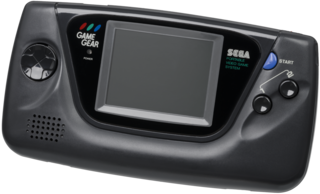
The Game Gear is an 8-bit fourth generation handheld game console released by Sega on October 6, 1990, in Japan, in April 1991 throughout North America and Europe, and during 1992 in Australia. The Game Gear primarily competed with Nintendo's Game Boy, the Atari Lynx, and NEC's TurboExpress. It shares much of its hardware with the Master System, and can play Master System games through the use of an adapter. Sega positioned the Game Gear, which had a full-color backlit screen with a landscape format, as a technologically superior handheld to the Game Boy.
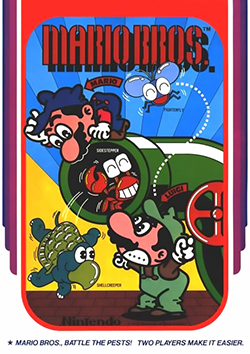
Mario Bros. is a platform game developed and published by Nintendo as an arcade video game in 1983. It was designed by Shigeru Miyamoto and Gunpei Yokoi, Nintendo's chief engineer. Italian twin brother plumbers Mario and Luigi exterminate creatures, like turtles (Koopas) and crabs emerging from the sewers by knocking them upside-down and kicking them away. The Famicom/Nintendo Entertainment System version is the first game produced by Intelligent Systems. It is part of the Mario franchise, but originally began as a spin-off from the Donkey Kong series.

The Game Boy Advance SP, released in Japan on February 14, 2003, is a sixth-generation handheld game console developed, released, and marketed by Nintendo that served as an upgraded version of the original Game Boy Advance. The "SP" in the name stands for "Special". It is the penultimate console in the Game Boy Advance product line before the Game Boy Micro, which was released in September 2005.
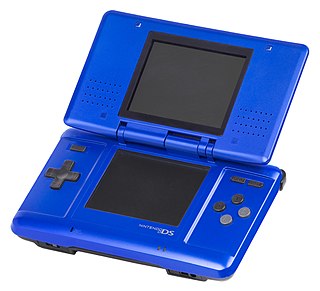
The Nintendo DS is a foldable handheld game console produced by Nintendo, released globally across 2004 and 2005. The DS, an initialism for "Developers' System" or "Dual Screen", introduced distinctive new features to handheld games: two LCD screens working in tandem, a built-in microphone and support for wireless connectivity. Both screens are encompassed within a clamshell design similar to the Game Boy Advance SP. The Nintendo DS also features the ability for multiple DS consoles to directly interact with each other over Wi-Fi within a short range without the need to connect to an existing wireless network. Alternatively, they could interact online using the now-defunct Nintendo Wi-Fi Connection service. Its main competitor was Sony's PlayStation Portable during the seventh generation of video game consoles.
2003 saw many sequels and prequels in video games, such as Tony Hawk's Underground, Madden NFL 2004, NBA Live 2004, ESPN NBA Basketball, Saya no Uta: The Song of Saya, Final Fantasy X-2, Mario Kart: Double Dash, Mario & Luigi: Superstar Saga, Prince of Persia: The Sands of Time, Sonic Heroes, Postal 2, Star Wars: Knights of the Old Republic, Uru: Ages Beyond Myst, and WWE SmackDown! Here Comes the Pain. New intellectual properties included Beyond Good & Evil, Boktai: The Sun is in Your Hand, Call of Duty, Disgaea, Drakengard, Manhunt, PlanetSide, TrackMania, True Crime: Streets of LA, and Viewtiful Joe.

The GameCube – Game Boy Advance cable (DOL-011) is a video game accessory manufactured by Nintendo which is used to connect the Game Boy Advance (GBA) handheld console to the GameCube (GCN) home console. Depending on the games it is used with, the cable may facilitate transferring data between related games, unlocking additional content, or turning the GBA into a controller or second screen.

iQue, Ltd. is a Chinese video game/game localization and support development company located in Suzhou. It was founded as a joint venture between Wei Yen and Nintendo in 2002 as a Chinese video game console manufacturing company. The following year, the company released the iQue Player. The company had manufactured and distributed official Nintendo products for the mainland Chinese market under the iQue brand until 2018.

The Nintendo DS Lite is a foldable handheld game console developed and manufactured by Nintendo. It is the second iteration of the Nintendo DS and is slimmer, brighter, and more lightweight than the original. It was announced on January 26, 2006, more than a month before its initial release in Japan on March 2, 2006 due to overwhelming demand for the original model. It has been released in Australia, North America, Europe, New Zealand, Singapore, and defined regions in South America, the Middle East, and East Asia. As of March 31, 2014, the DS Lite had shipped 93.86 million units worldwide.

The Nintendo Game Link Cable is an accessory for the Game Boy line of handheld video game systems, allowing players to connect Game Boys of all types for multiplayer gaming. Depending on the games, a Game Link Cable can be used to link two games of the same title, like Tetris, or two compatible games like Pokémon Red and Blue. Games can be linked for head-to-head competition, cooperative play, trading items, unlocking hidden features, etc.
This is a list of video game accessories that have been released for the Game Boy handheld console and its successors. Accessories add functionality that the console would otherwise not have.

The Japanese multinational consumer electronics company Nintendo has developed seven home video game consoles and multiple portable consoles for use with external media, as well as dedicated consoles and other hardware for their consoles. As of September 30, 2021, in addition to Nintendo Switch, Nintendo has sold over 863.07 million hardware units.
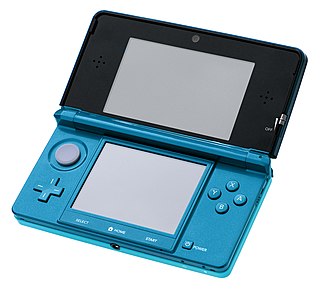
The Nintendo 3DS is a foldable handheld game console produced by Nintendo. The console was announced in March 2010 and unveiled at E3 2010 as the successor to the Nintendo DS. The system features backward compatibility with Nintendo DS video games. As an eighth-generation console, its primary competitor was Sony's PlayStation Vita.
The following is a sales history for the Nintendo DS family.
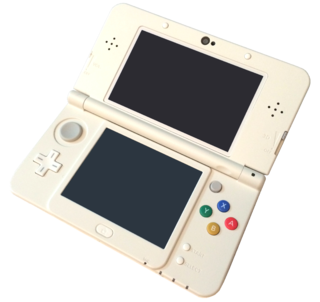
The New Nintendo 3DS is a foldable handheld game console produced by Nintendo. It is the fourth system in the Nintendo 3DS family of handheld consoles, following the original Nintendo 3DS, Nintendo 3DS XL, and Nintendo 2DS. The system was released in Japan on October 11, 2014, in Australia and New Zealand on November 21, 2014, on January 6, 2015 in Europe in a special Club Nintendo-exclusive "Ambassador Edition", and at retail in Europe on February 13, 2015. Like the original 3DS, the New Nintendo 3DS also has a larger variant, the New Nintendo 3DS XL, released in all three regions. In North America, the New Nintendo 3DS XL was released on February 13, 2015, while the standard-sized New Nintendo 3DS was released later on September 25, 2015.
















